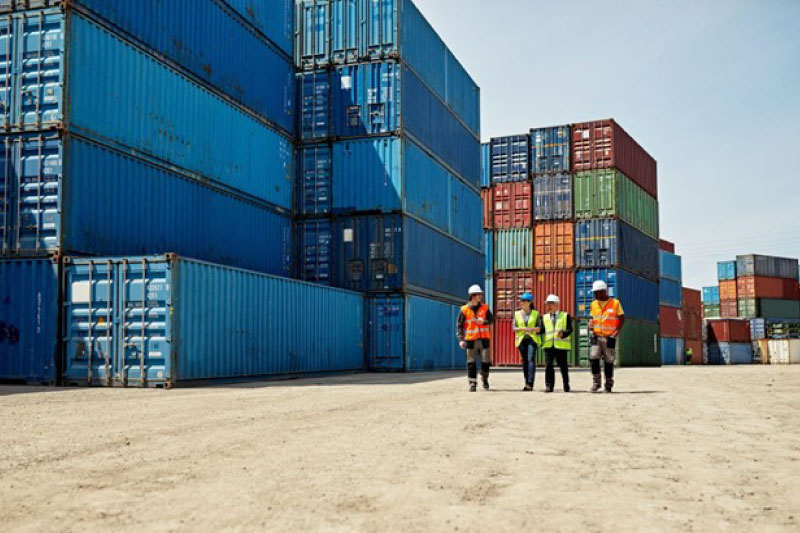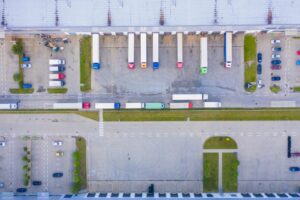Contents
Real-time location systems (RTLS) are transforming the way logistics and supply chain strategies are implemented. RTLS is rapidly becoming an essential tool for businesses to monitor, track, and manage their inventory.
By providing real-time information about the location of items within a facility or across multiple sites, businesses can enhance accuracy, expedite operations, and reduce costs. RTLS also offers unprecedented insight into the status of shipments, granting organizations a better understanding of their inventory movements.
Considering these advantages, RTLS is revolutionizing logistics and supply chain planning and management strategies for companies worldwide. This blog post will delve into how RTLS revolutionizes logistics and supply chain management strategies in detail.
By the end of this blog, you will gain a better understanding of how RTLS impacts the chain strategies and how companies manage their logistics and supply chains in today’s competitive market. Moreover, you will learn about the numerous benefits of using RTLS and some potential challenges to consider when implementing this technology.
What is RTLS Technology?
Real-time location systems utilize a combination of radio frequency, infrared, or ultrasound technology to precisely track the real-time location of individuals, assets, and products. In logistics and supply chain management strategies, RTLS is extensively employed due to its capability to monitor inventory movements in near real-time accuracy. It also provides unparalleled insight into shipment statuses, thereby enhancing organizations’ understanding of their inventory movements.
Compared to traditional methods like barcode scanning and GPS tracking, RTLS holds an advantage by being based on radio frequency technology. It can accurately track items within a specified range, typically up to 100 meters, without necessitating a direct line of sight between the item and the reader. This makes RTLS more reliable and less susceptible to interference caused by obstacles like walls or other large environmental objects.
RTLS for Supply Chain
Implementing Real-Time Location Systems (RTLS) in supply chain management is transforming how businesses track and manage their assets and inventory, ensuring unprecedented efficiency and accuracy. By leveraging Litum’s advanced RTLS technology, companies can gain real-time visibility into every stage of their logistics operations, from warehousing to transportation. This not only accelerates processes but also significantly reduces the risk of errors and delays, boosting overall operational productivity. Embrace the power of RTLS with Litum, and propel your supply chain management into a new era of innovation and performance, ensuring you stay ahead in the competitive market.

What are Some Challenges Faced in Logistics and Supply Chain?
Before exploring how RTLS can revolutionize logistics and supply chain management, it is crucial to consider some of the challenges encountered in these industries.
Overwhelming Demand
The logistics and supply chain market of today confronts an unprecedented level of demand. With the expanding global population and increased consumption, there has been a significant surge in the volume of goods that need to be transported, stored, and handled across multiple touchpoints. This surge poses challenges for logistics companies as they grapple with meeting this heightened demand. For instance, when goods must be shipped from a manufacturer to a distribution center, and subsequently to multiple retail endpoints, managing the complexity of thousands of shipments can become increasingly challenging, even for seasoned professionals.
Mismanagement and Inefficiency
Another challenge prevalent in the logistics and supply chain industry is mismanagement and inefficiency, often stemming from a lack of visibility into operations. Without implementing measures to track the movement of goods throughout the process of shipping, storing, and handling, it becomes difficult to identify and resolve bottlenecks.
Additionally, companies experiencing disruptions in their supply chains may lack the necessary information to make informed decisions that could enhance operational efficiency. This can result in wasted time, money, and resources, as shipments face delays or go missing.
Increased Regulation
The logistics and supply chain industry also faces mounting compliance burdens due to various government regulations. Companies must ensure that their chain strategies and operations comply with these regulations, necessitating frequent auditing and reporting measures that would otherwise be avoidable in the absence of stringent oversight. This adds complexity and requires allocating resources to ensure compliance with all applicable laws and regulations.

Security Concerns
Lastly, security poses another significant challenge in the logistics and supply chain industry. As goods traverse the supply chain network, they must be safeguarded against theft or tampering. Companies must maintain constant vigilance and implement robust security measures to ensure the safety of goods and inspire customer trust in their services.
Typically, companies rely on physical security measures such as locks and surveillance cameras, but these measures are not infallible.
In conclusion, the logistics and supply chain industries encounter numerous challenges. However, technological advancements have provided solutions that assist companies in surmounting these challenges and remaining competitive in this ever-evolving market.
How RTLS is Revolutionizing Logistics and Supply Chain Management
Having explored the challenges faced by logistics and supply chain management companies, let us now delve into how RTLS can revolutionize the management of these industries.
Improving Warehouse Safety
Safety is a significant concern in warehouses, where high-risk accidents can occur. Real-time location systems offer an immediate solution to this problem by enabling employers to accurately track and monitor the movement of people, equipment, and vehicles within the warehouse.
By gaining better insights into activities within their facility, companies can reduce the occurrence of potential accidents and save costs associated with lost time and medical expenses. RTLS also assists employers in identifying hazardous areas, coordinating traffic flow, ensuring proper safety gear usage by all personnel, and keep tabs on visitors entering the facility. Additionally, it can alert staff if dangerous situations arise, such as a forklift driving too close to a pedestrian.
RTLS also provides the benefit of tracking the location and timing of maintenance activities for equipment and machinery. This enables employers to schedule regular inspections and repairs, thus minimizing the risk of accidents. Moreover, it aids in future spending planning, as accurate estimates can be made regarding required maintenance and appropriate timelines.

Enhancing Visibility into Operations
RTLS also plays a vital role in helping logistics and supply chain companies enhance visibility into their operations. By providing accurate location data, they can monitor inventory levels in real time. This capability enables agile supply chain companies to maintain an optimal stock level for their customers, ensuring a balance between meeting demand and avoiding unnecessary financial burdens.
Furthermore, RTLS offers valuable insights into operational processes, including delivery and customer service response times. Companies can utilize this data to identify areas requiring improvement and consistently meet customer expectations.
Additionally, bluetooth low energy (BLE) technology plays a crucial role in enabling real-time location tracking systems to accurately track the location of assets or people within a confined area. By placing BLE beacons throughout the premises to transmit signals to receivers, real-time tracking of individuals or assets becomes possible. This significantly enhances the accuracy and reliability of RTLS, leading to improved operational efficiency and customer satisfaction.
Finally, RTLS empowers businesses to effectively track their assets, reducing the risk of loss or damage while improving asset utilization. By utilizing RTLS to track asset movement, companies can identify areas of underutilization or overutilization. This enables them to optimize their supply chain operations, resulting in reduced costs for asset acquisition and maintenance.
Reduction of Stockouts and Overstocking
One of the most significant benefits of using real-time location systems in logistics and supply chain management is the reduction of stockouts and overstocking. By leveraging RTLS alongside an effective supply chain strategy, businesses can accurately monitor inventory levels in real time, ensuring sufficient stock to meet demand while mitigating the risks associated with overstocking.
Stockouts occur when a business runs out of a particular product, resulting in lost sales, missed opportunities, and potential damage to the business strategy and customer relationships. On the other hand, overstocking transpires when a business holds excessive inventory, leading to increased storage costs, wastage, and obsolescence.
RTLS helps businesses avoid both scenarios by providing real-time information on inventory levels and movement, enabling an effective supply chain strategy. By closely tracking the movement of products within their facilities and supply chain, businesses can identify demand patterns and adjust inventory levels accordingly. They can also detect anomalies or delays in the supply chain that may impact inventory levels, taking proactive measures to mitigate risks.
Reducing stockouts and overstocking allows businesses to improve operational efficiency, reduce costs, and foster better customer relationships. They can swiftly respond to shifting market demands and minimize lead time for restocking products. Consequently, they gain a competitive advantage in the marketplace and solidify their position as a reliable and responsive supplier that meets customer demand consistently.

Minimizing Equipment Downtime
Equipment downtime can have a significant impact on operations, causing delays, increased costs, and reduced productivity. By utilizing RTLS to monitor equipment health in real time, businesses can proactively schedule maintenance, thereby reducing the risk of unexpected equipment failures and minimizing downtime.
RTLS allows businesses to monitor equipment performance in real time, taking into account factors such as temperature, humidity, and vibration. By implementing automated alerts and notifications, businesses can receive real-time updates on equipment status and take proactive measures to minimize failures. For instance, they can schedule maintenance based on usage patterns and wear and tear, rather than waiting for a breakdown to occur.
In addition to proactively scheduling maintenance, RTLS helps businesses enhance the efficiency of their maintenance operations. By providing real-time location data on equipment, businesses can optimize maintenance routes, reducing travel time and improving the speed of response to maintenance requests. They can also ensure that maintenance personnel have the necessary tools and equipment, minimizing the need for multiple repair trips.
By minimizing equipment downtime, businesses can improve operational efficiency, reduce costs, and boost customer satisfaction. They can ensure that their equipment always operates at peak performance, thereby reducing the risk of delays and failures in their operations. Through real-time equipment monitoring facilitated by RTLS, businesses can proactively address potential issues and maintain smooth operations.
Reduced Costs and Waste
By providing real-time insights into the location and movement of assets, businesses can identify inefficiencies and streamline operations to reduce costs effectively. For instance, RTLS can be used to optimize the routing and scheduling of vehicles and personnel, resulting in reduced transportation costs and improved efficiency. Real-time inventory tracking enables businesses to minimize waste, avoid overstocking, and prevent stockouts, ensuring that the right products are always available to meet customer demand.
Furthermore, real-time location tracking solutions assist businesses in optimizing energy usage, thereby reducing their carbon footprint, and lowering costs. Through monitoring asset and personnel movement, businesses can identify opportunities to decrease energy consumption, such as turning off lights and equipment when not in use. This not only leads to cost savings but also promotes sustainability and responsible resource usage.
Enhancing Supply Chain Management with Litum
Litum‘s real-time location tracking solutions empower businesses to optimize their operations by providing valuable insights into the movements of personnel and assets in real time. With this information at their fingertips, businesses can make data-driven decisions that improve efficiency, reduce downtime, and ensure operational continuity. Leveraging the power of RTLS, businesses can also achieve their sustainability goals and optimize their supply chain management strategy while improving their bottom line.
Contact us today to discover the transformative power of real-time location tracking.




